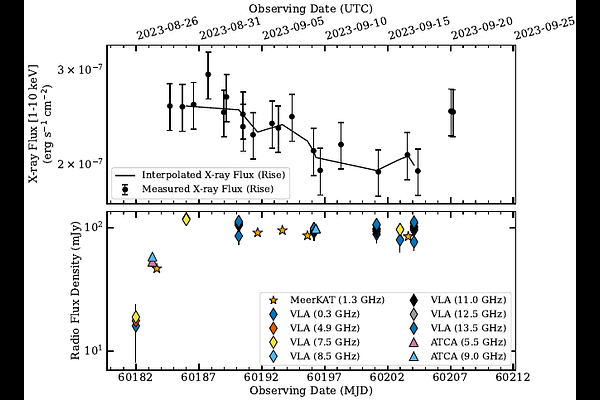The peculiar hard state behaviour of the black hole X-ray binary Swift J1727.8$-$1613

The peculiar hard state behaviour of the black hole X-ray binary Swift J1727.8$-$1613
A. K. Hughes, F. Carotenuto, T. D. Russell, A. J. Tetarenko, J. C. A. Miller-Jones, R. M. Plotkin, A. Bahramian, J. S. Bright, F. J. Cowie, J. Crook-Mansour, R. Fender, J. K. Khaulsay, A. Kirby, S. Jones, M. McCollough, R. Rao, G. R. Sivakoff, S. D. Vrtilek, D. R. A. Williams-Baldwin, C. M. Wood, D. Altamirano, P. Casella, N. Castro Segura, S. Corbel, M. Del Santo, C. Echiburu-Trujillo, J. van den Eijnden, E. Gallo, P. Gandhi, K. I. I. Koljonen, T. Maccarone, S. B. Markoff, S. Motta, D. M. Russell, P. Saikia, A. W. Shaw, R. Soria, J. A. Tomsick, W. Yu, X. Zhang
AbstractTracking the correlation between radio and X-ray luminosities during black hole X-ray binary outbursts is a key diagnostic of the coupling between accretion inflows (traced by X-rays) and relativistic jet outflows (traced by radio). We present the radio--X-ray correlation of the black hole low-mass X-ray binary Swift~J1727.8$-$1613 during its 2023--2024 outburst. Our observations span a broad dynamic range, covering $\sim$4 orders of magnitude in radio luminosity and $\sim$6.5 in X-ray luminosity. This source follows an unusually radio-quiet track, exhibiting significantly lower radio luminosities at a given X-ray luminosity than both the standard (radio-loud) track and most previously known radio-quiet systems. Across most of the considered distance range ($D {\sim} 1.5--4.3$ kpc), Swift~J1727.8$-$1613 appears to be the most radio-quiet black hole binary identified to date. For distances ${\geq} 4$ kpc, while Swift~J1727.8$-$1613 becomes comparable to one other extremely radio-quiet system, its peak X-ray luminosity (${\gtrsim} 5{\times}10^{38}$ erg/s) exceeds that of any previously reported hard-state black hole low-mass X-ray binary, emphasising the extremity of this outburst. Additionally, for the first time in a radio-quiet system, we identify the onset of X-ray spectral softening to coincide with a change in trajectory through the radio--X-ray plane. We assess several proposed explanations for radio-quiet behaviour in black hole systems in light of this dataset. As with other such sources, however, no single mechanism fully accounts for the observed properties, highlighting the importance of regular monitoring and the value of comprehensive (quasi-)simultaneous datasets.